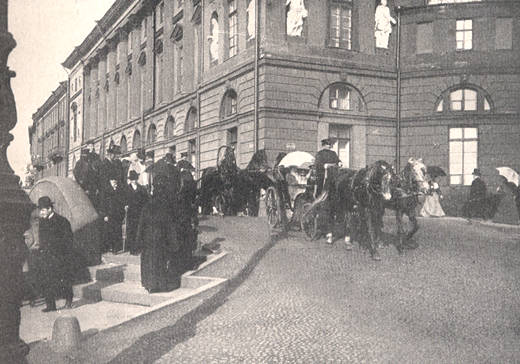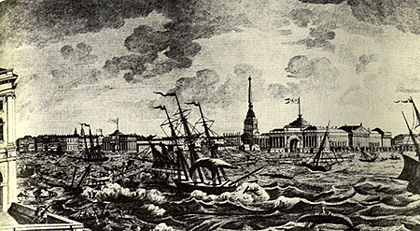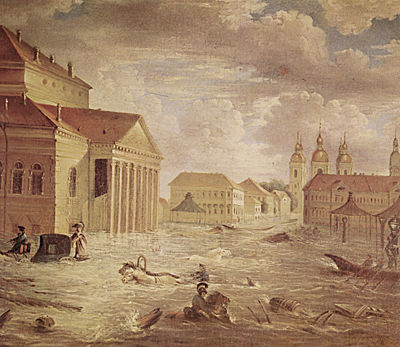   

Here we see traffic on the Neva side of the Winter Palace where people are passing over an arched canal bridge. The white statues in niches decorate the red-painted Hermitage Theatre, built for Catherine the Great in 1780's. During the reign of Alexander II most state buildings were painted with this same dark color, which was part of a modernizing campaign in the city. The idea was to both 'update' and make public buildings easy to recognize. Alexander III got a very good deal on this color of paint, so brick red it was. Thus a bad idea and cheap paint lead the defacement of St. Petersburg. In a couple of years teams of painters had covered generations of pastel tones - colors that had made buildings, like the Winter Palace, so delightful to the eye - with a dark and depressing cloak of thick paint.
Building after building fell under the painter's brush, the Anichkov Palace, the General Staff building, even Peterhof. The paint did not do well in the St. Petersburg climate, it peeled, became stained and bleached out in patches marring these buildings even more.
This picture above was taken in later April, when it could still be quite cold and late snows were not uncommon. Storms could rise suddenly at any time of the year and the memory of the worst of them kept people on their toes when bad weather approached. On November 7, 1824 a terrible wind storm mixed with snow and rain hit the city in the morning. Strong, northerly winds blew and the rain fell in torrents from a dark, steely grey sky; people brave enough to be on the streets watched in horror as water was seen backing up through the sewers - gushing out. The water rose very fast, people fled to higher floors of buildings grabbing what they could. There was no where to run, Petersburg is very flat and there was no high ground to escape to.
 Above: A contemporary print of the great flood of 1824.
The great flood engulfed the center of the city as the water rose through street grates and overflowed the Neva Embankment bursting into houses, shops, churches and palaces alike - finally reaching depths as great as 12-14 feet. Squares resembled lakes and streets wide rivers. People traversed the city in boats. Since most of Petersburg's shops were on the ground floor of buildings most of them were destroyed, their owners watching in grim silence as their business sank underwater. Millions of rats were killed. Ships from the Neva were swept into the city by the flood and were sent crashing into buildings by the gale-force winds, later to be left marooned in squares and the middle of streets. When the flood retreated from the city a strong counter current pulled back towards the river, drawing furniture,lumber, firewood and lots of refuse with it - back over the river parapet and into the Neva. It all headed out towards the Baltic sea where the mouth of the river was clogged with debris of all kinds. It seems that around 1500 lives were lost in the storm. Even today such flooding threatens the city and many smaller floods have struck since.  Above: A painting of the great flood of 1824.
Next photograph: The Hermitage Museum
For a small map of the St. Petersburg area click here.
To see a large map of the center
of St. Petersburg go here.
Comments on the website should be sent to Bob
Atchison. |
 |
|

